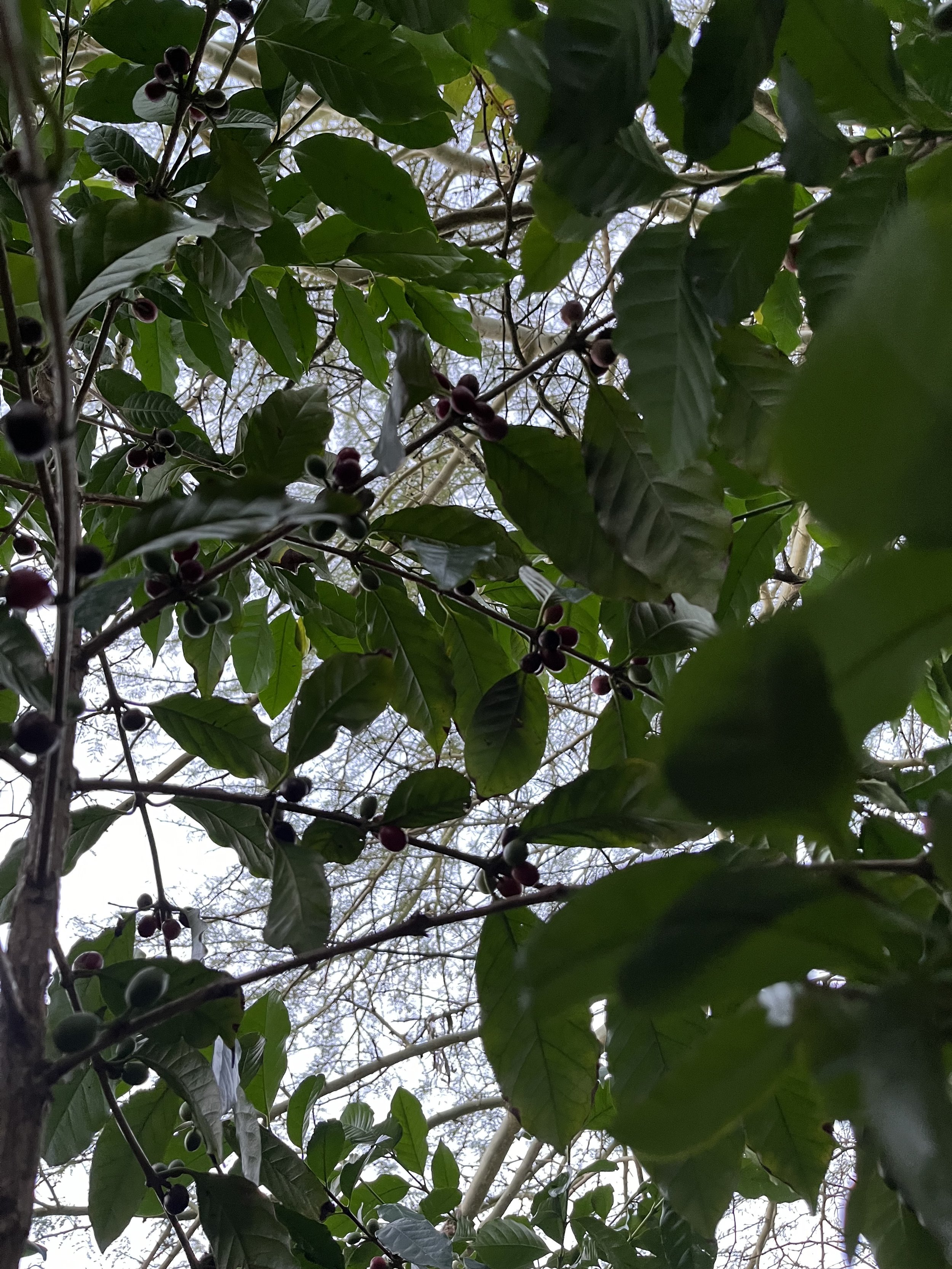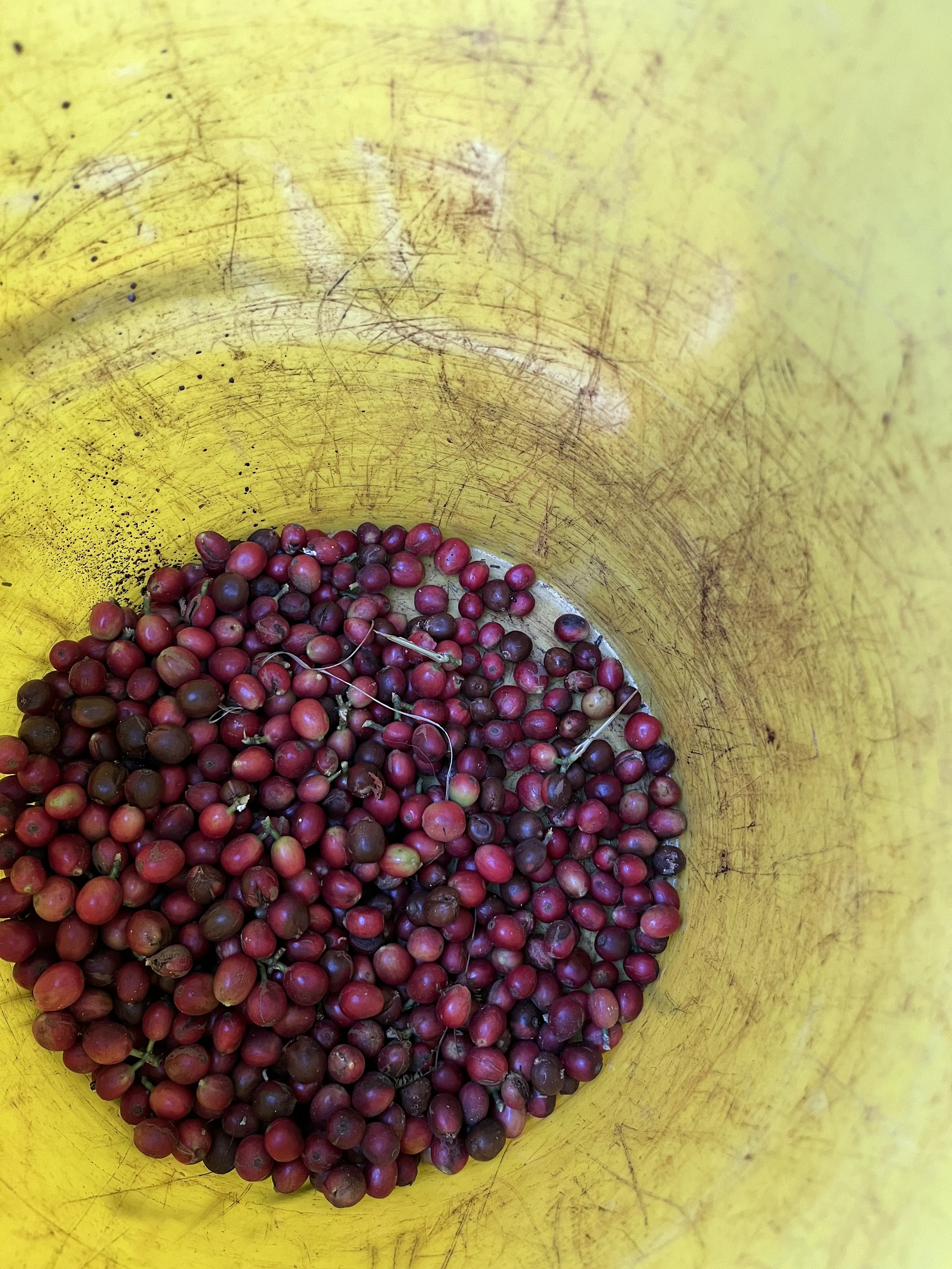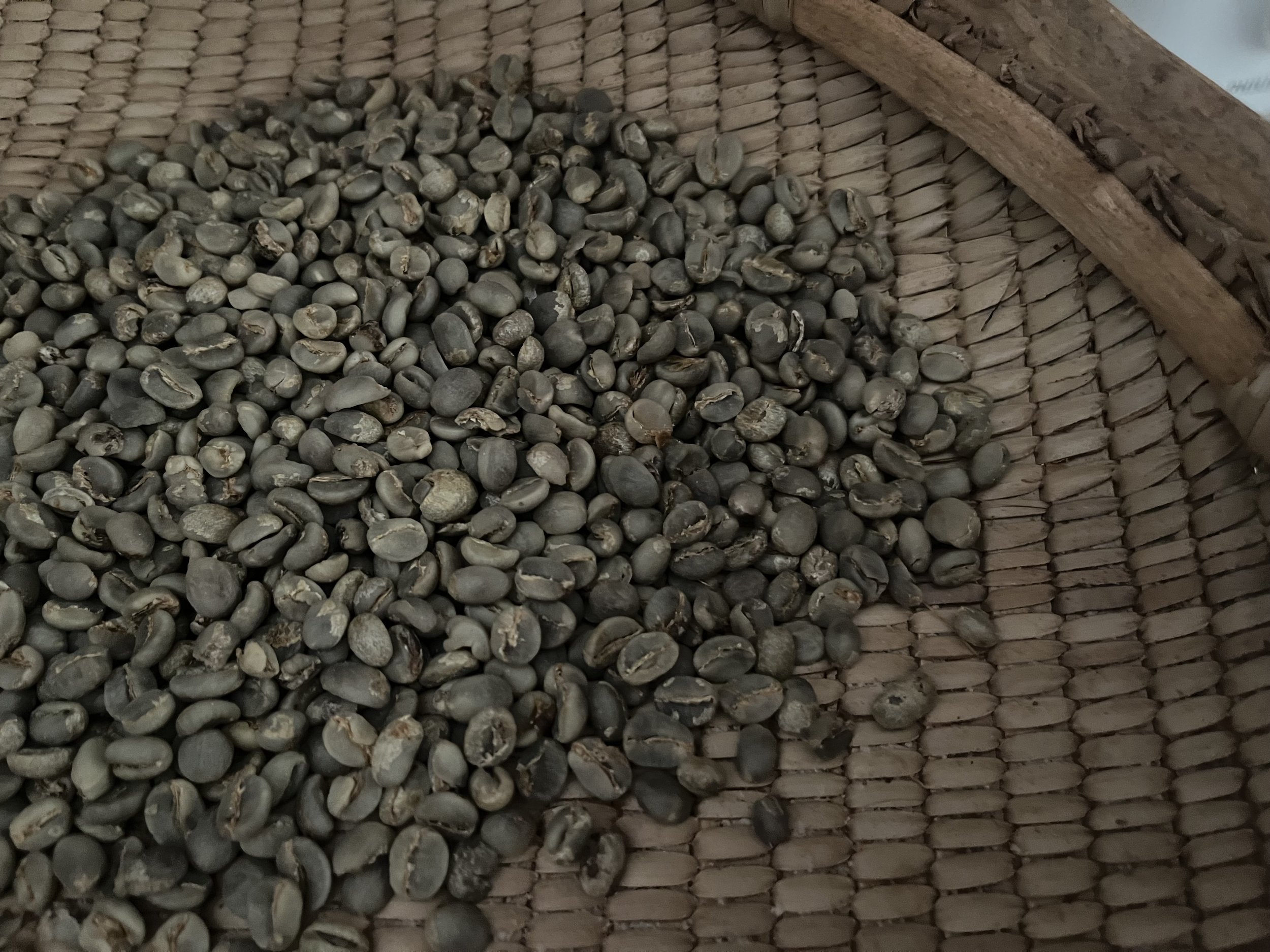(Scroll down to read in English)
モザンビークの田舎、ナマーシャに引っ越しする一つのきっかけとなったのが、私が住んでいた素敵な家に出会ったことだ。
裏庭からみた我が家 / A view of my house from the backyard
立派な一軒家で、大きな庭がある。
この庭には、パパイヤ、ライチ、レモン、アボガド、パッションフルーツ、ピタンガ、ジャックフルーツ、桑、バナナといったフルーツの木もあって、沢山その恵みをいただいた。
そしてなんとこの庭には、コーヒーの木も10本ほど植えられていたのだ。
私はコーヒーを飲むのは好きだが、栽培や精製については殆ど知らない人だった。
この家に住むことになり、春になると白い花をつけ、緑色の実(チェリー)がなり、やがて真っ赤に熟していく姿を観察する中で、こりゃ飲まにゃあ勿体ないなと思って、独学で収穫してみたのが始まり。
コーヒーの栽培・精製の世界は奥が深い。
まずはコーヒーの木の品種から始まり、栽培する環境、収穫方法、精製方法によって最終的なコーヒーの味が変わる。
私の家の庭にあったコーヒーの木の品種は?
厳密にはわからない。
葉やチェリーの形・色などでアラビカ種であることは明確。
そしてアラビカ種といってもその中でさらに多数の亜種がある。
この家の元オーナーで、おそらくこのコーヒーの木を植えたであろう女性はもう亡くなってしまっていて、誰もこのコーヒーの木の厳密な品種を知らない。
自分の背よりも高いコーヒーの木に潜り込む / Diving inside the canopy of a coffee tree taller than myself
品種はどうであれ、まずは自分で精製してみようということで、3月ごろ、モザンビークでは夏から秋に向かうタイミング、赤色に熟したチェリーを手で収穫していった。
チェリーは最初緑色だったものがまずは真っ赤になり、そこからさらに完熟になると深いワインレッドになる。
全てのチェリーが同じタイミングに熟してくれればいいが、そうはいかず、熟しすぎたものも未熟なものもあり選択が必要。
熟しすぎたものは、実が腐って小蝿がたかってたりする。
コーヒーの実に顔を突っ込んで甘い果汁をちゅーちゅー吸ってるカナブンもいた。
完熟したチェリーは甘い。
作業をしていると、手が果汁でべとべとになる。
コーヒーチェリーの果汁を吸いにくるカナブン / A beetle enjoying the sweet juice from a ripe coffee cherry
完熟したチェリーを探して、自分の背丈よりも高い木の中に潜り込み、ひたすら収穫。
ワインレッド色のチェリーを求めて。
宝探しようで夢中になってしまう。
するとあっという間に時間が過ぎ、気付くとバケツにたくさんのチェリーが獲れている。
収穫したてのコーヒーチェリー / Freshly harvested coffee cherries
収穫後、チェリーを水で洗い、ざるに乗せて乾燥させる。
目指すのはチェリーの水分量が10〜11%になるところ。
ただしそれを測る器具をもっていないので、適当に乾燥させる。
乾燥の特に初期の段階は、水分量が多く、蠅や蟻が寄ってくる。
あまり良くないんだろうが、最終的には乾燥させた種(=コーヒー豆)をゲットするのが目的なので、あまり気にせず、とにかく日向に置いて乾燥させることに注力。
この時期、つまり冬のモザンビークは、基本晴れているので、チェリーの乾燥にはもってこいの環境。
冬のモザンビークの太陽でコーヒーチェリーを乾燥させる / Drying the coffee cherries in the winter sun
乾燥したなと思ったら、これまたアナログで、木の臼で叩いて、果肉と豆を分離させる。この臼は、前回のモザンビーク料理の投稿時にも書いたものと同じもので、モザンビークの田舎の一般家庭では大体置いてある道具。
叩くことで果肉だけでなく、豆の外についているパーチメントという薄皮も分離することが可能。
少々根気のいる作業だが、従業員たちに手伝ってもらって、みんなで会話したり歌ったりしながらお庭で作業してれば楽しい。
様々な工程を経て、ついに生豆ゲット / After various processes, finally the raw beans are ready
これでようやく、コーヒーの生豆ゲットです。
ミリタリーっぽい薄い緑色。
明確に計ってないけど全部の木からチェリーをかき集めて、自分が家で飲む上では十分な量のコーヒー豆があったし、運営していたカフェでも提供した。
ローストして人にプレゼントもした。
ローストしたてのお豆さんたち / Freshly roasted coffee beans
そんな風にコーヒーまで庭から手に入ってしまって、私のモザンビークでの食生活はものすごく豊かなものになっていた。
手間と時間は必要だけど、その使った分の手間と時間が、喜びとありがたみに比例していたと思う。
そんなありがたいコーヒー、飲んでもとても美味しかった。
私にとっては、人生に、多少の不便さやDIYをする機会があった方が、楽しくて豊かな生活を送れると実感した。
面倒臭いと感じることも多々あるけど〜。
みんなで庭でワイワイ、手作業でコーヒー豆を処理する / Processing the coffee all by hand, in the garden, with my team.
この庭だけではなく、自分がモザンビークの農園で目論んでいたコーヒーのプロジェクトや、自分が考えるコーヒーの価値についてなど、追々書いていきたいと思う。
One of the elements that led me to move to Namaacha, a small town in rural Mozambique, was the lovely house that I was fortunate to move into.
It was a beautiful house with a large garden.
The garden had many fruit trees; papaya, lychee, lemon, avocado, passion fruit, pitanga, jackfruit, mulberry and banana, all of which enriched my life.
And to my surprise, there were also about 10 coffee trees planted in this garden.
I was a coffee drinker but knew little about growing and processing of coffee.
After a year of living in this house, I observed the white flowers bloom in the spring, green cherries emerging and after a while ripening into red colour.
The world of coffee growing and processing is a deep one.
It starts with the variety of coffee tree, the environment in which it is grown, the harvesting method and onto the processing method, all of which affect the final taste of the coffee.
What variety of coffee tree was in my garden?
Its is unknown.
It is clear from the shape and colour of the leaves and cherries that it is an Arabica species.
And there are many varieties within the Arabica species.
The former owner of the house who probably planted this coffee tree has passed away and no one knows the exact variety.
Whatever the variety, I decided to try processing the coffee myself, so around March - the timing of the transition from summer to autumn in Mozambique - I harvested the red ripe cherries by hand.
Cherries start off green and turn bright red, then ripen to a deep burgundy as they completely ripen.
It would be nice if all the cherries ripened at the same time, but this was not the case. Some are ripe and some are unripe, so selective harvesting was necessary.
The over-ripe cherries are often rotten and attract small flies.
Beetles of particular kind were seen sticking their faces into the coffee cherries and sucking the sweet juice.
Ripe cherries are sweet.
My hands would become sticky with juice when harvesting.
In search of ripe cherries, I would dive in between the branches of the trees taller than me.
Its like a treasure hunt; I would easily become obsessed in the search of burgundy-coloured cherries.
Time flies and when I realise, I would find lots of cherries in the bucket.
After harvesting, the cherries are rinsed with water and placed on straw sieves to dry.
The proper target is to dry the cherries to a moisture content of 10-11%.
However, I didn’t have the equipment to measure this, so I just did it with my gut feeling.
In the early stages of drying, the moisture attracts flies and ants.
It's probably better if they are not there, but the ultimate goal is to get dried seeds (= coffee beans), so I didn't worry too much about it and just focused on drying them as quick as possible under the sun.
In this time of the year, the winter season in Mozambique, the weather is basically sunny, which really helps with the drying process.
When I think they are dry, I would then put them into a wooden mortar and crush the cherries with a pestle, to separate the pulp from the beans.
This mortar is the same one I wrote about in my last Mozambican cooking post, and is a tool that is usually found in ordinary homes in rural Mozambique.
By pounding, it is possible to separate not only the pulp, but also the thin skin called parchment that is attached to the the beans.
This process needs a bit of power and effort, but its a fun process when I would work with the help of my employees, while everyone is chatting and singing together in the garden.
Finally, you get green coffee beans.
Its light moss greenish colour.
I didn't weigh it properly, but after collecting the ripe cherries from all the trees, I had enough coffee beans for me to enjoy coffee at home and for serving coffee at the café I was running.
I also gave some freshly roasted coffee beans to my friends.
So, I even got some fresh coffee from the garden like this, and this made my life in Mozambique extremely rich.
It takes a lot of time and effort, but I think that time and effort spent just came back to me in the form of joy and gratitude.
Adding such gratitude, the coffee tasted extra delicious.
From this experience, I realised that for me, having a certain level of inconvenience and opportunities for DIY makes my life much more fun and rich.
Of course, there were many occasions when I didn’t feel like taking the hassle…
I hope to write more about not only this garden, but also about the coffee project I was planning alongside my farm, and my own view of the value of coffee, in future posts.







